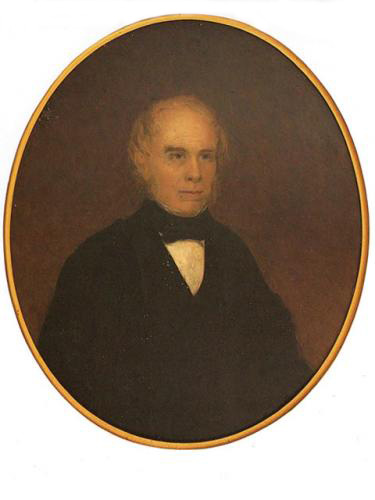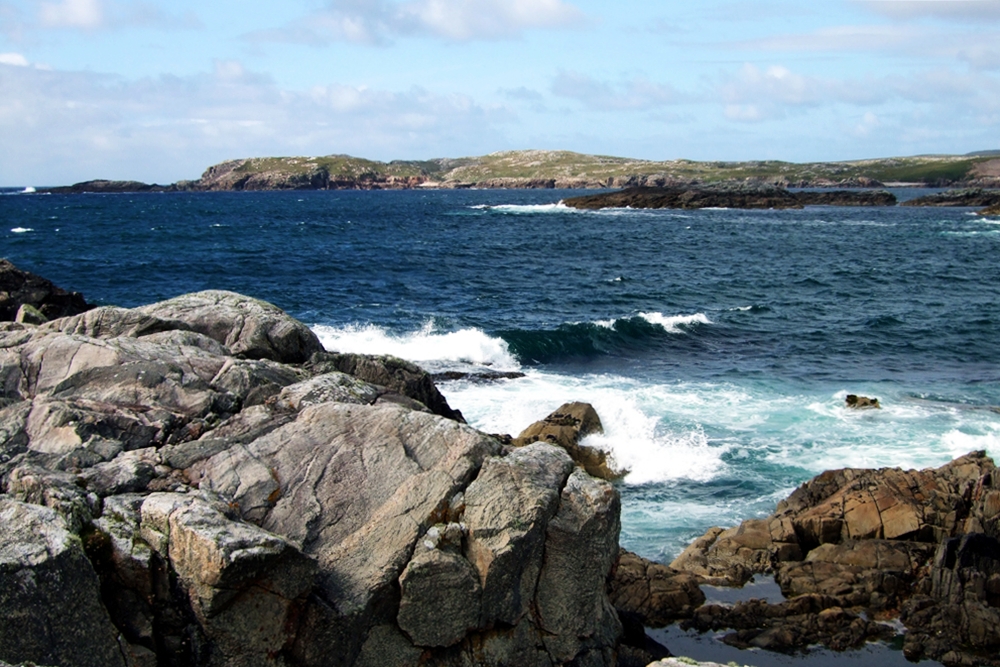Tag: timsgarry
Donald Macdonald, DSM
A Church in Trinidad
William MacGillivray in Uig

The renowned naturalist William MacGillivray was born in Aberdeen in 1796 and studied and worked most of his life there or in Edinburgh, but he had a Harris connection through his father and spent much of his childhood at Northton in South Harris (where the MacGillivray Centre now bears his name). As a young man, he returned to spend 1817-1818 there, and his diaries of that period have been published as A Hebridean Naturalist’s Journal (Acair 1996). In October of 1817 he and a party of friends and relations made a journey to Uig.
Luachar, Saturday, 18th October.
Let me describe the scenery, shooting grounds, house and its inhabitants. The scenery is generally of the grand order with little or no beauty. We have a long series of lofty mountains, turning into ridges & forming deep glens. These mountains are all rugged & precipitous, they run north-east and south-west. Stretching toward the north from them are low hills and extensive plains several miles in length and toward the south higher hills & vallies. On the declivities and under the rocks are the haunts of the deer, not easily found by a stranger, but well known to the inhabitants. Loch Rezort terminates the ground of sport on the north, the ocean on the west and south, and the Lewes on the east. The whole ground is broken into little eminences & depressions, covered with heath and some other plants – at this season of the year of a yellowish or brown colour, which renders it extremely difficult to see the deer – though the broken nature of the surface facilitates an approach to them when discovered.
The house, our place of rendezvous, is situated at the distance of between one and four miles from the places of resort of the deer, at the head of an arm of the sea which constitutes part of the northern boundary of Harris. It is what in the Hebrides is denominated a black house and what Dr Johnson calls a hut. Its inhabitants are Ewen McDiarmid, a shepherd in the employment of a gentleman of Kintail who has a very extensive tract in Harris under sheep, a tough, unpolished, but honest and civil man advanced in years; his wife Christina McCaskill, daughter of Mr McCaskill schoolmaster of Uig in Lewis, a genteel woman of about thirty; little John their son, a comical cross-grained boy; two female servants, the one a clumsy lump, the other a half-idiot with only one eye.
Luachar, Thursday, 30th October.
On Sunday, the 19th, Ewen and Miss Nelly and I and little John went to Toray, a small farm two miles down Loch Rezort on the Lewis side. One of our incitements to go there was to see two children of Ewen’s who were lodged there. Here we were treated with cream and potatoes. I made a very hearty repast. The vessels which held the cream were only two in number, so the good-man and the good-woman and Ewen were placed about one, while Miss Nelly and I got the other. Had any other arrangement been made, I had been disgusted, and I could not refuse to partake of their fare without being liable to the imputation of pride. We returned in the evening.
Fishing Boats in Uig
Hogmanay in the Capital, 1943
Transport
Crowlista School 1937
Prosperity and Overcrowding in Uig, 1850s-1890s
Summer Outings
Crowlista School c1952
Rev David Watson’s Boundary Dispute
David Watson was ordained as minister of Uig in 1845 but as the congregation had mostly migrated to the Free Church, his Church remained largely empty. He was at odds with the people and the estate, as the following notes in the 1851 diary (published by Acair) of the Chamberlain John Munro Mackenzie attest:
Thursday 13 February
Walked to the Manse of Uig and found Mr Watson busy planting potatoes and clearing his arable land of Stones with a number of men employed. Went to the Parish School [at Taigh Chiosamuil] & found it quite crowded there being more than 40 scholars present, and on enquiring the cause was told that Mr Watson gave notice to the people that unless they sent their children to school he would pindfold every sheep & cow of theirs he found on his grass – He expects to get the parents to attend his Church in the same way but I fear he will be disappointed.
Monday 24 March
Went to office and was engaged meeting parties viz… Rev Mr Watson regarding claim for damages for not clearing his farm of Mr Mitchell and small tenants at Whitsunday last, tho’ he agreed and wished to accommodate Mitchelll – Got him to sign a Minute drawn up by Mr [Donald] Munro agreeing to withdrawing his claim & promised to give him the small place of Miavaig which lies into his farm, there are three small tenants here at present occupying it who can be removed to Carishader in place of those going to America.
Thursday 15 May
Went to office and was engaged meeting & paying Ministers Stipends & Schoolmasters salaries — The Rev Mr Watson produced a most extraordinary a/c of £31 made up of various idle claims for damages for mans not being repaired, damages to pasture etc etc which I denied & refused payment in toto and stated to Mr Watson my surprise at his presenting such an a/c – He replied that he would not have done so but that he was hard pressed for cash, having to pay the whole of his stipend for his stock, I offered to give him some delay in the payment of £20 to £30 if he withdrew the a/c which he refused but wished to refer it which I refused as I considered the whole to be absurd –
Seonnaidh Mòr on the Subject of Milk
The Dewar Commission, charged with investigating the state of medical provision in the Highlands and Islands, interviewed, amongst others, John Macrae (Seonnaidh Mòr), the farmer at Timsgarry, on 12 October 1912 at Garynahine. The questions are put by the chairman, Sir John Dewar MP.
You have three nurses in the parish, and the nuring is very satisfactory?– Yes, very satisfactory indeed.
Have you room for more nurses?– Yes. We would certainly require another nurse. It is a very wide district. It extends from here away up to the other end – it is something like thirty miles – and there is only one nurse [in West Uig]. I think we require two.
Could you tell us in your own way in what way the nurses benefit the people?– Well, the greatest benefit they are to the sick people is in the way of dieting; again, in maternity cases they are a great benefit.
You think they have considerable effect on the habits of the people in teaching them how to live properly?– Yes.
Can you give us any indication of how a crofter lives? Can you tell us what sort of diet they live on?– Yes.
What have they for breakfast?– As a rule they have oatmeal porridge and milk.
The Charge Sheet: We Have Waited Long Enough (1913)
On the day in November 1913 when the Reef Raiders drove the stock from Reef Farm, the local Constable made the following report (the list doesn’t correspond exactly to the men identified in the photo):
Charge, Breach of the Peace
Police Station
Miavaig, 28th November 1913
Sir,
I beg to report to you that between the hours of 10am and 1pm on Friday the 28th day of November 1913, on Reef Farm, occupied by Alexander Macrae, Farmer in the Parish of Uig
1. Malcolm Macritchie (64), Married, Squatter, Fisherman, Kneep
2. Allan Morrison (56), Married, Crofter, No 3 Kneep
3. Donald Morrison (49), Married, Squatter, Fisherman, No 13 Kneep
4. Murdo Macdonald (52), Married, Squatter, No 2 Kneep
5. John Morrison (48), Single, “alias” Cooper, No 13 Kneep
6. Murdo Mackay (25), Single, (Angus Son), No 30b Valtos
7. Donald Matheson (54), Married, Squatter, Fisherman, Valtos
8. Alexander Mackay (41), Married, Squatter, Fisherman, Valtos
9. Alexander Macdonald (60), Married, Squatter, Fisherman, Valtos
10. Angus Mackay (26), Single, (Norman Son), Fisherman, Valtos
11. Norman Mackay (24), Single, (Malcolm Son), Fisherman, Valtos
12. Donald Morrison (23), Single (Malcolm Son), Fisherman, Valtos
13. James Morrison (20), Single (Murdo Son), Fisherman, Valtos
14. Donald Maclennan (18), Single (Widow John Son), Valtos
all in the Parish of Uig.
Did form in a body and forcibly and unlawfully enter said farm, there gathered together all the sheep about 200 in number, and 5 head of cattle, and drove them to the march stone dyke which they knocked down, and forced them over the broken wall, thereafter drove them together across the moor through Kneep and Uigen to Miavaig public road, thence along the road through Valtos Glen to Timsgarry Farm, occupied by John Macrae, Farmer, all to the terror and alarm of both farmers, and in breach of the public peace.
Long an Iaruinn: the Ship of Iron
Dolly Doctor, in Tales and Traditions, tells of the wreck of a ship at Carnish in 1775. In the picture Sgeir an Iaruinn is the small island in the middle of the picture, with Shielibhig in the distance on the far left.
All night the people round Uig Bay had listened to the cries of woe and frightful screaming from the crew of the ship gone aground, as piece after piece broke away from the ship and the crew were being washed overboard; but they could do nothing to help them, for no boat could live in those awful waves and the night was inky black. She was a big ship, and had come into Camas Uig the evening before, seeking shelter in the lea of Sgeir Sheilibhig, putting out two anchors for futher safety. The wind began to get stronger as night came on, and by midnight it was blowing a howling gale right into Uig Bay. She began to drag the two anchors until she scudded before it, gaining momentum all the time, until she struck on a sunken bogha with such for that she gave off a loud clang as of metal being struck, so that all the houses in Carnish and Crowlista heard the noise. This was a mortal blow for it ripped part of her timbers off, then she scurried with renewed force onto the sharp fangs of the skerry at Carnish Point, where the mighty billows kept on tearing her asunder, but she was well out from the land and no human being could get to her on such a night of doom.


